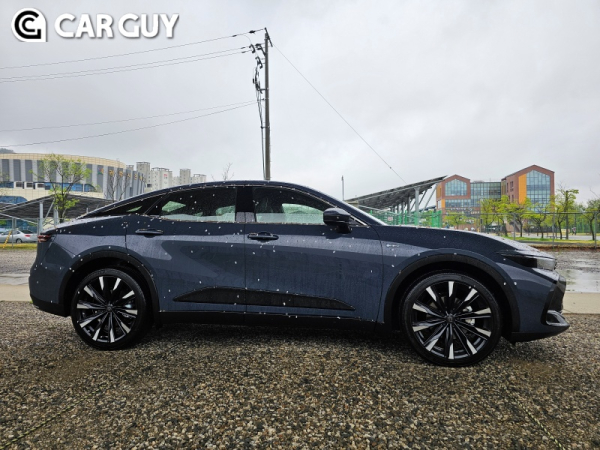Toyota has the fun of driving..meet a crown crossover
Apr 27, 2025
|
The Crown is Toyota's first mass-produced flagship car and has changed since its first launch in 1955. It is currently a 16th generation model.As the brand has been maintained for a long time and is a representative model of Toyota, which has been honed through 16 major changes, it has started to test drive with expectations.
From the 16th generation, Crown serves as a top-end sub-brand rather than a single model. A total of four models under the Crown name - crossover, sport, sedan, and estate - have been released in different styles. Unfortunately, only the crown crossover came out in Korea.
There are two basic hybrid power trains with a 2.5-liter natural inhaler engine and a new dual-boost hybrid with a 2.4-liter turbo engine. The test drive is a 2.4 dual-boost hybrid model.
The most noticeable part of the front is the newly applied crown emblem. Instead of the Toyota emblem, the crown brand is at the forefront. The front part with Toyota's new design signature Hemmerhead has a sleek first impression. It adds sophistication to the simplicity and neatness of the old Toyota.
The design features are on the side. Away from the traditional three-box sedan design, the roofline runs smoothly to the trunk lid. To live up to the name of the crossover, the lowest ground level was raised. By introducing a black glossy material for cladding, the characteristics of sedans and SUVs were taken at the same time.
The wheel also emphasized the dynamic image by applying a two-tone color to a large size of 21 inches.The rear side placed a thin horizontal LED taillight across the left and right to give a futuristic image. A thin tail lamp line is applied to the thick rear to create a different ratio.
Unlike the exterior with a slightly unconventional design, the interior feels safe and stable. The dashboard shape is designed around the driver. The 12.3-inch center monitor was placed at the top, so the visibility while driving was high.
The digital instrument panel with the same 12.3-inch size was conservative as the housing surrounding the border was in the analog days, but it helped with daytime visibility.Overall, it is also eye-catching that there are many physical buttons.Design-wise, some button designs feel like analog days rather than the latest vehicles.
Although the sophistication was somewhat inferior, the physical button was placed in the right place, making it convenient to use while driving. The steering wheel is made of a material with a good grip rather than a soft leather. The button operation was also easy.
Electronic gear is a gear rod type. This is a method commonly used in Toyota vehicles. It is intended to be operated after pulling to the left, reducing misoperation and being intuitive, making it convenient to use.
One of the advantages I felt in the crown crossover is the driver's seat. Although the material did not feel particularly good, there was little fatigue in driving for a long time due to the excellent seating feeling. The seating and comfort of the driver's seat can give a good score as an advantage I felt during the Lexus vehicle test drive.
The second row space has plenty of legroom thanks to its generous wheelbase of 2850mm.There was plenty of headroom thanks to the high electricity of the crossover. In the case of trunk space, the glass does not open like a lift bag, but the wide opening of the sedan type makes it easy to store bulky luggage.
I woke up the heart of the 2.4 Dual Boost Hybrid by pressing the start button. The 2.4 dual-boost hybrid model is Toyota's first high-performance system that combines a serial four-cylinder turbo engine with a rear-wheel eAxle.
It has a different direction from a general Toyota hybrid that values efficiency. The combined output of 348 horsepower is higher than 239 horsepower of the 2.5 natural inhaler hybrid. Instead, the 2.5 hybrid combined fuel efficiency is 17.2 km per liter, while the 2.4 dual boost is only 11 km per liter.
In addition, an electronically controlled variable suspension is applied to adjust attenuation power according to road conditions and create an optimal ride. It also features a four-wheel drive method in which a separate motor is applied to the rear wheels. It is a system called E-four that focuses on fast distribution of driving power and securing grip power in bad conditions.
The initial accelerator responsiveness is heavy compared to recent electric vehicles. Therefore, you may misunderstand that the performance is normal, but if you step on the accelerator, the engine sound wakes up and shows a strong sense of acceleration. It is a large sedan with a raised body, but it also shows a sports car-like intensity.
Instead, it doesn't feel luxurious in terms of sound insulation. Although it is not particularly noisy, the overall quietness was average, perhaps because the first row door was glass rather than double-junction.
The advantage was in cornering. Even if you run on a curved road at a high speed, you did not feel anxious because you displayed a tight grip thanks to the four-wheel drive applied with the rear-wheel electric motor.
Break is also a linear sensation rather than initial responsiveness, and it feels weak at low speeds. However, if you break suddenly at high speed, the speed deceleration is achieved as fast as you want. Even if you encounter a curved road surface at an urgent corner, the electronic damper quickly corrects the attenuation force, providing a stable posture and a comfortable ride.
Instead of having excellent cornering performance, the hard suspension feeling on roads with severe irregularities such as manholes made me feel that the focus was on dynamic exercise performance rather than riding.
I tried dynamic cruise control. Driving assistance is generally at an easy level. The overall setting is conservative, which delivers the warning faster than expected. It can be seen that the vehicle is generally set to be safety-oriented, such as the operation of the center monitor is also not allowed to be operated when the operation begins.
After the test drive of the crown crossover, the preconceived notion that Toyota is not fun was broken without a doubt. Although it expected a smooth, quiet and soft ride like a luxury car, the test drive equipped with a 2.4 dual boost focused on dynamic acceleration and excellent cornering performance.
If you want quietness and a smooth ride, the Lexus ES300h would be better suited.Crown crossover will be a good option if you don't like SUV-specific rolling in vehicles with high road levels because they often drive in places with bad roads and want dynamic driving sensitivity and compliance fuel economy.
a line review
Advantages: Hybrid that emphasizes performance differently than before..Excellent acceleration and cornering performance
Cons: You might be disappointed if you expect the quietness of a luxury vehicle..have a conservative interior design
Editor Song Moon-cheol mc.song@carguy.kr
This article was translated by Naver AI translator.














